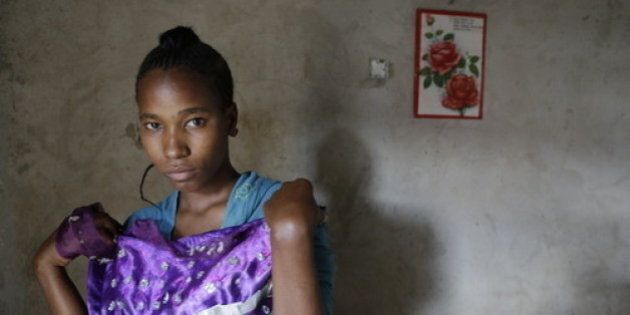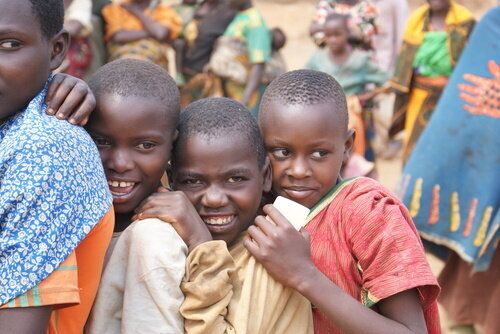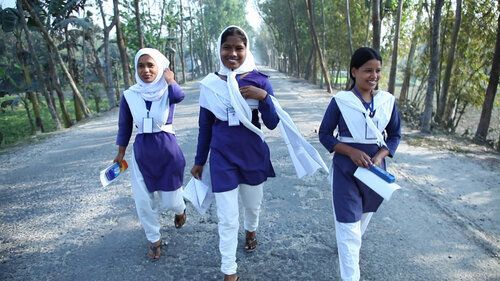
At age 13, Latifa was sold into an abusive marriage to a man twice her age. She has since escaped the relationship with her young son. Here, Latifa poses with her wedding dress.
She was 13, maybe 14. Her home was a refugee camp in Mexico for Guatemalans who had fled civil war. Her job was taking care of five younger brothers and sisters while her mother worked in the fields. I met her almost two decades ago, but I see her face in every story about Syrian refugees on the move today. And I think about the terrible dangers that may lie ahead for adolescent girls among them.
I was an intern with the UN High Commission for Refugees and excited about my first job. My eyes were soon opened to the realities of life in a "temporary" refugee camp in which some had spent a decade. Families flee to escape violence. What I began to learn was that violence -- particularly sexual violence -- was a fact of life in the cauldron of a crowded camp of people in limbo.
All women and children are vulnerable in such situations; adolescent girls are the most vulnerable. Many are separated from adult protectors. They walk alone to toilet and washing facilities offering little privacy. They are easy targets. Some resort to selling their bodies for food and money.
In my subsequent work in international development, I came to understand that girls living in poverty across the developing world are also much more likely to be subjected to violence than their brothers. They walk long distances to school in communities where many believe girls have no business being in school. Many are forced against their will into marriage and intercourse in their teens. Two out of three victims of child trafficking around the world are girls.

Burundian girls queue for supplies in a refugee camp in Rwanda.
(Photo: Plan International/Sergio Rubio)
I now know the problem isn't just "out there" and of course it doesn't go away when girls grow into women. This Sunday, December 6 marks the 26th National Day of Remembrance and Action on Violence Against Women. It's the anniversary of the massacre of 14 female engineering students in Montreal by a gunman who in his suicide note blamed feminists for ruining his life.
That was long ago and in many ways the world has changed. There are more women in positions of great power. And yet discriminatory notions persist here in Canada. Consider the case of the Canadian Federal Court Justice who, presiding at a rape trial last year, persisted in calling the 19-year-old victim "the accused" and wondered aloud why she couldn't just keep her knees together. I wonder why those who might secretly suspect women they know are victims of violence don't act on their suspicions, no matter how high-profile or seemingly upstanding the offenders may be.
We know that marginalized women and girls, such as those with intellectual disabilities, are even more vulnerable, with between 40 to 70 per cent estimated to face sexual abuse before their 18th birthday.
I remain optimistic. Finally there is real momentum towards seeing the inquiry into the missing and murdered aboriginal women become a reality. There are other encouraging signs of growing outrage and some real progress toward coordinated action. The new UN Sustainable Development Goals to 2030 -- successors to the Millennium Development Goals and a roadmap for building the world we want -- recognize that progress made over the past 15 years has tended to focus on those easiest to reach. Over the next 15 years world leaders have pledged to work harder to reach everyone.

16-year-old Monufa (right) was set to become child bride until a local Plan partner organization intervened to recommend that she be allowed to finish her education. Here, she's pictured walking to school with her friends.
(Photo: Plan International/Emily Packer)
Plan Canada is among those who have long been calling for a national action plan to end violence against women and children in Canada. Our international work has shown us that the problems are multi-faceted and solutions must be holistic. We do not want to take steps to see that a girl is protected in school only to see her abused on the way home.
A national strategy will see all levels of government and service providers working together to stop vulnerable women and girls from falling through the cracks. Canada's new Minister for the Status of Women, Patricia Hajdu, is listening, with the boldest commitment yet to see a national gender violence strategy become a reality. We are calling on her to look at both women and children in this endeavour, address the acute crisis for indigenous women, and the particular vulnerability of adolescent girls.
Stronger coordination is important and unrelenting public pressure can make governments around the world take action. But until public opinion unanimously refuses to turn a blind eye to the actions of all perpetrators of violence, the vulnerable will continue to be vulnerable. We must educate, advocate and act to make this happen.
Amanda Sussman is head of policy and advocacy for Plan International Canada. She is also the author of The Art of the Possible: A Handbook for Political Activism.
MORE ON HUFFPOST:
